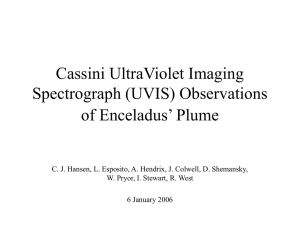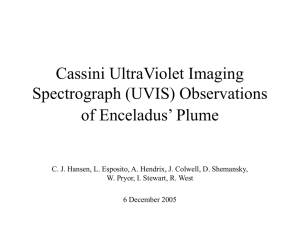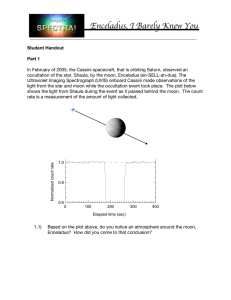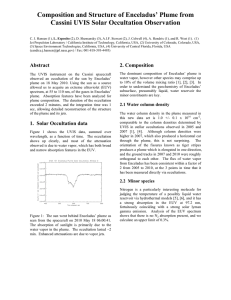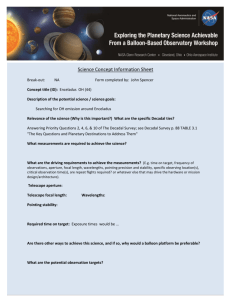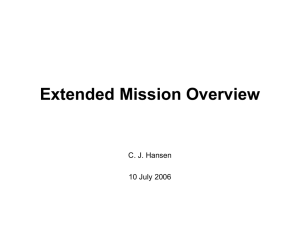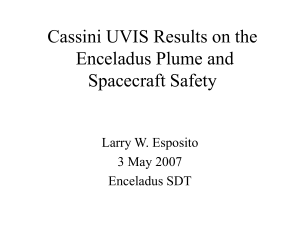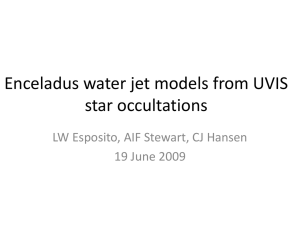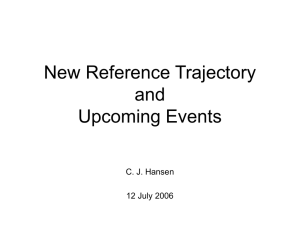Enceladus’ Water Vapour Plumes UVIS Observations in the Extended Mission
advertisement
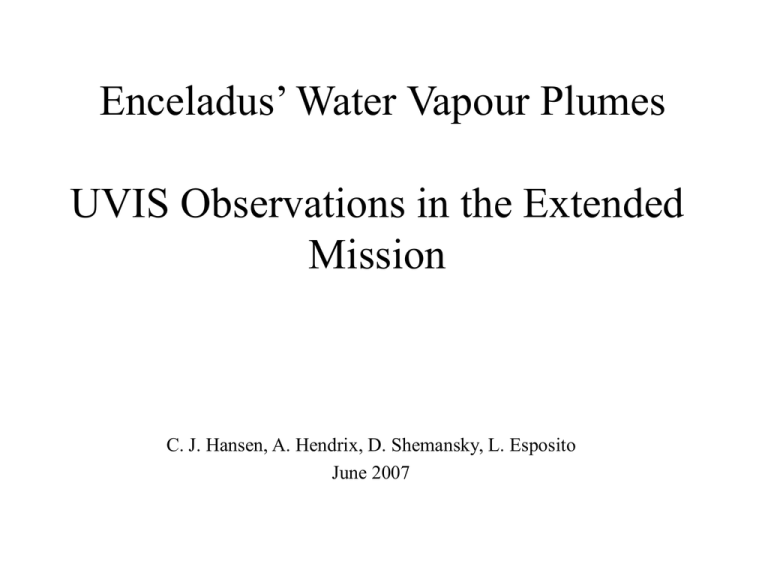
Enceladus’ Water Vapour Plumes UVIS Observations in the Extended Mission C. J. Hansen, A. Hendrix, D. Shemansky, L. Esposito June 2007 UVIS Science Objectives - Overview Most Important • Observe occultation of gamma Orionis to – Observe temporal variability – Reconstruct vertical structure -> important constraint on what is happening in the interior because we derive vertical velocity – Calculate water flux • Capacity to re-supply the E ring is still not completely certain • (no question that the atomic oxygen in the system can be maintained by Enceladus) • Observe occultation of the sun to measure nitrogen – Previously, presence of nitrogen was inferred from INMS measurements combined with UVIS upper limit on CO – Can definitively detect nitrogen in a solar occultation and get column density as a function of altitude Also • Observe distant stellar occultations of the plume with the HSP to look for density variations (like Rev 51) • Observe system oxygen in Enceladus’ vicinity as a proxy for activity Gamma Orionis Occultation - Rev 88 Gamma Orionis goes right behind the plume Faster occ than in the primary mission -> choice between snr and vertical resolution Previous Stellar Occ Results (brief reminder) Composition of Plume is Water Vapour I=I0 exp (-n*) I0 computed from 25 unocculted samples n = column density = absorption cross-section, function of wavelength The absorption spectrum of water (pink line) is shown compared to Enceladus’ plume spectrum (I/I0) for a column density of n = 1.5 x 1016 cm-2 More Recent Fit • Water absorption modelled by Don Shemansky • New water absorption cross-sections used • Better fit to data • New column density = 1.6 x 1016 cm-2 • But no significant change in results • Old column density = 1.5 x 1016 cm-2 Structure of the Plume The increase in water abundance is best fit by an exponential curve – a comet-like evaporating atmosphere (1/R2) does not fit the data well, nor do global hydrostatic cases The best fit scale length is 80 km Monte Carlo model results - Predicted Plume Shape The 0.1 contour => column density = 1016 Monte Carlo Model - Fit to Data Best fit to UVIS column density as a function of altitude requires a vertical velocity of 300 to 500 m/sec New calculation of water flux is 4 - 6 x 1027 molecules/sec, consistent with lower rate from previous estimate, = 120 - 180 kg/sec Solar Occultation Rev 131 • We have the opportunity to observe an occultation of the sun on Rev 131 • New results are in the EUV, which gives us access to a different wavelength range than the FUV • The big scientific payoff is the chance to definitively detect / measure nitrogen in the plume - important for models of chemistry-driven dynamics in the interior Solar Occultation How well can UVIS measure N2 with a solar occultation? • Abundance of H2O measured by UVIS = 1.5 x 1016 cm-2 • Mixing ratio of mass 28 in the INMS experiment at Enceladus was [M28]/[H2O]=0.036 • A solar occultation has been simulated for our H2O optical depth assuming a commingled mixture of H2O and N2 in the spectral region of the H Ly line • The ability to measure N2 in a mixing ratio of [N2]/[H2O] = 0.005 is indicated, for an abundance of N2 = 1 x 1014 cm-2 How do we know? • N2 was measured above the exobase in the UVIS T10 solar occultation observation using the measured extinction of the sol H Ly line by the N2 b(3,0) band. Solar Occultation • This is a simulation of the results we could get from a solar occultation by Enceladus’ plume • UVIS can detect N2 absorption near 972 Ang • Mixing ratio for blue curve, showing clear absorption, is 0.05, close to the INMS derived value of [M28/H2O] = 0.036 • Green curve shows likely detection limit with an order of magnitude less nitrogen, or [M28/H2O] = 0.005 Solar Occultation • Reduced amount of water vapor simulation • (Further from source so need to take this into account) Enceladus Plume Occultation In Rev 51 there is an opportunity to get a stellar occultation of Enceladus’ plume This is the perfect geometry to detect density variations in the gas jets We’d like more of these in the XM (greater distance is ok) Changes in System Oxygen Content - Proxy for Activity Changes at Enceladus UVIS System Scans in the XM • MAG TWT included system scans in their request for apoapsis segments • We requested – On all orbits with period > 15 days • 8 hr/day • Apoapsis +/- 4 or 5 days • Segmentation status is that there won’t be a cross-discipline TWT, but instead large orbits will fall into either the Saturn or the MAG TWT – They are all in the second year of the XM, beginning with Rev 109 – After Cassini is back in the equatorial plane – This is assuming that we don’t get time in the 7 Rings equinox orbits • Leaves ~20 orbits as opportunities • Likely competitors for apoapsis time will be ISS (but we can avoid them by picking orbits with high phase angles) and CIRS XM Orbit Petal Orientation The sun is to the right Backup Slides Solar Occultation Enceladus Stellar Occultation Geometries February Lambda Scorpii Occultation July Gamma Orionis Occultation Egress Ingress Estimation of Water Flux from Enceladus • S = flux = N * h2 * v = n/h * h2 * v = n*h*v Where N = number density / cm3 h2 = area v = velocity n = column density measured by UVIS The biggest uncertainty is what to use for h Estimate h from plume dimension, = 80 (from scale length) or 175 km (from horizontal distance traversed) h v Estimate v from thermal velocity of water molecules in vapor pressure equilibrium with warm ice (41,200 at 145 K or 46,000 cm/sec at 180 K – note that escape velocity = 23,000 cm/sec) S = 1.5 x 1016 * (80 or 175) x 105 * (41 or 46) x 103 = 0.5 to 1.2 x 1028 H2O molecules / sec = 150 to 360 kg / sec Detection of Plume: High Speed Photometer (HSP) vs. Time • Clear indication of attenuation of signal during occultation ingress; egress is signature of HSP warmup • Start to sense atmosphere ~24 sec prior to hard limb occultation, maybe as much as 30 sec (FUV) • Ray height at –24 sec is ~ 155 km Localization of Enceladus’ Plume (Not a global atmosphere) • Ray intercepts were at latitude / west longitude: 15 / 300 -31 / 141 -76 / 86 -0.2 / 28 Lambda Sco ingress (non-detection) Lambda Sco egress (non-detection) Gamma Ori ingress Gamma Ori egress (non-detection) Consistent with localized plume or jet: – Enceladus’ gravity insufficient to hold gravitationally bound sputtered atmosphere – Also, the combination of other Cassini data sets are consistent with a plume of water vapor coming from Enceladus’ “Tiger Stripes” driven by the hot spot at the south pole detected by CIRS “Search for the Missing Water Source”1 Neutral Species • Water and its products are lost from the system by collisions, photoand electron- dissociation and ionization • Estimates of required re-supply rates, water molecules/sec: • • • • 2.8 x 1027 3.75 x 1027 1028 2 x 1028 1993 2002 2005 2005 Shemansky, et al. 1Jurac, et al. Jurac and Richardson Shemansky, et al. E Ring • Saturn’s E ring, composed primarily of 1 micron particles, is also subject to erosion and loss due to sputtering of water from the surface of the E ring’s dust particles and collisions of particles with Saturn’s moons • Estimate of required re-supply rate: • 1 kg / sec 2002 Juhasz and Horanyi New Plume Model • A new model has been developed for Enceladus’ plumes by Tian, Toon, Larsen, Stewart and Esposito, paper submitted to Icarus • Monte Carlo simulation of test particles given vertical + thermal velocity, particle trajectories tracked under influence of gravity and collisions • Assumes source of one plume is 2 x 2 km2, then multiple plumes added together along a tiger stripe, separated 20 km UVIS ray path across tiger stripes Dust in the Plume - Is Enceladus the source of Saturn’s E Ring? Enceladus as source of E Ring was first proposed in 1981 by Terrile and Cook, based on coincidence of peak density of E ring with Enceladus’ orbit Lifetime of 1 micron grains is short (<50 years) E ring re-supply required is 1 kg/sec • Comet analogy, using UVIS water vapor mass • If dust-to-gas ratio is comet-like then ratio ranges from 0.1 to 2 • 0.1 x 150 kg/sec > 1 kg/sec required • ISS results on dust densities suggest that the ratio is much lower - just 0.04 kg/sec of 1 micron particles • From the rate of impacts on the CDA High Rate detector the particle escape rate is inferred to be 5 x 1012 particles/sec or 0.2 kg/sec assuming all grains have a radius of 2 microns Detecting Temporal Variability The water budget derived from the water vapor abundance shows Enceladus supplies most if not all of the OH detected by HST, atomic oxygen in the Saturn system detected by UVIS Implies activity for > 15 years Since the oxygen in the system comes from Enceladus UVIS may be able to remotely monitor Enceladus’ activity levels by monitoring the system oxygen level Oxygen atoms (x10-34) Weekly O1304 Trend 3.0 2.8 2.6 2.4 2.2 2.0 1.8 1.6 1.4 1.2 1.0 0.8 1.1 1.0 0.9 0.8 0.7 0.6 0.5 0.4 0.3 0.2 0.1 0.0 (a) (b) 0 Z: +5/-5 Rs, X: -6/-10 Rs Z: +5/-5 Rs, X: 0/+6 Rs Z: +5/-5 Rs, X: +6/+10 Rs Z: +5/-5 Rs, X: 0/-6 Rs 100 200 300 400 Elapsed Time (days) 500 600 700 Detectable Effects on Magnetosphere At Enceladus • Some of the neutrals in the plume are ionized by charge exchange • Fast-moving co-rotating plasma overtakes Enceladus, gets slowed down by mass-loading of slow-moving Enceladus plasma • Plasma flow (sensed by CAPS) is slowed and diverted at a distance of 27 RE In Saturn’s magnetosphere, away from Enceladus’ immediate vicinity, • The neutral density dominates the plasma density – Large tori of H, OH, O • • Charge exchange is the primary ionization process and proceeds slowly, resulting in relatively long average neutral lifetimes (~70 days) Heavy ions supplied to inner magnetosphere are gradually accelerated to corotation velocity, transported outward Enceladus L shell crossings show • Changes in absorption signatures of energetic electrons suggest plume variability on time scales of days to weeks 2008 Enceladus Flyby Cassini will fly by Enceladus again on March 12, 2008 This is a polar pass, with the closest approach near the equator We approach from the unilluminated side Just minutes after Cassini passes to the illuminated side Enceladus goes into eclipse The closest approach distance has not yet been finalized but will be < 100 km We expect to clip the plume again on the southbound asymptote Intrigued by Enceladus Enceladus will be an important target for more flybys in Cassini’s extended mission Enceladus should be the destination for a future mission! Neutral Species in Saturn’s System • The Saturnian system is filled with the products of water molecules: – H detected by Voyager in 1980, 1981 – OH detected by Hubble Space Telescope in 1992 – Atomic Oxygen imaged by UVIS in 2004 CO Limit • The Ion Neutral Mass Spectrometer (INMS) detected a species with mass = 28 amu, consistent with either N2 or CO • UVIS should have detected CO: – Used absorption cross-sections from Eidelsberg, 1992 – “Require” 10% dip in signal for positive detection I/I0 = 0.9 = exp (-nα) for α = 820 x 10-18 at 1477.6 Å -> n = 1.3 x 1014 cm-2 upper limit, ~1% • VIMS also places an upper limit of ~ 1014 cm-2 • Implies an INMS detection of N2 since UVIS should have seen 3% CO Enceladus Flybys in 2005 Orbit 3 Orbit 4 Orbit 11 Range = 1259 km Subs/c lat = 200 Subs/c lon= 3080 Range = 497 km Subs/c lat = -170 Subs/c lon = 2540 Range = 168 km Subs/c lat = -510 Subs/c lon = 2180
